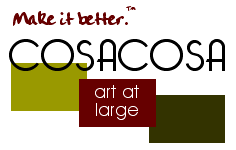



In the early part of the twentieth century, the American pragmatist philosopher John Dewey wrote, “the function of art, the highest form of communication, is to fix those standards of enjoyment and appreciation with which other things are compared.”
In Dewey’s treatise of aesthetic philosophy, Art as Experience, he argues that our interaction with art is the very basis on which societies are built, because “art is the realm of communication in which completed acts are expressed.” He believed that without art or an understanding of the significance of art, social relationships and society itself could not function.
Dewey believed that people are unconsciously stimulated into certain ways of thinking -- and therefore behaving --- by the presence of art, and that in this way, people of a single community find a common ground on which to set their standard of living. He went on to say that by refining our knowledge of art, we refine our “taste” and become more sensitive to the needs of community members and the community’s potential, and to the further appreciation of art, which in turn creates a greater sensitivity to social needs. In his writings, Dewey sees a back and forth relationship between the arts and society where the standard of living and the artistic contribution is continually enhanced…
Government funding and policy-making has helped to support a growing cultural industry in this country. And now, in the early years of the twenty-first century, research in psychology, education and economics is bringing fuller meaning to Dewey’s work: the arts play a significant, if not central, role in our identity and the well-being of our society.
Children exposed to the arts from birth are more likely to be high achievers in school, be more confident, and interact better with their peers. A report by the Arts Education Partnership documents that in an arts-integrated education program, students show improved ability to understand complex issues and emotions; problem solving dispositions/strategies; self-confidence, motivation and ability to focus; nonverbal reasoning; verbal skills and writing skills; and reasoning about scientific images. Additionally, children with early arts exposure continue to value and patronize the arts throughout their lifetime.
The arts as an economic engine is well documented with many sources pointing to the arts as the basis for a healthy business community in cities and small towns. Municipal governments now encourage centers of artistic life as added value to attracting business and professional workers, and many cities are now turning to the arts to help solve social problems such as violence and substance abuse.
Public art resulting from this activity puts a soul into the concrete and asphalt of a community. Public art transforms space designed for functionality and traffic flow into a more welcoming environment. A study done by the Arts Council England found that most citizens did not distinguish between public art and the place it was located. For the people who lived and worked there, the art was what created the impression of, and feelings for, the area. Though people were not always able to fully articulate their connection with the art, the study also found they generally felt safer and more in touch with their community when their surroundings included art.
What facilitates this connection between the arts and society is cultural leadership. A cultural leader interprets and translates the arts experience. What is the relationship between arts and society? What connects the artist and the audience? Cultural leaders integrate the meaning of art with discussion to create a conversation among people about their values, and in doing so foster the ongoing development of social standards and quality of life. A philanthropist who donates money to develop a new work, a teacher who helps students understand a piece of art, a writer who explains the symbolic meaning of a painting, play or symphonic work, are all examples of cultural leadership.
Cultural leaders also work to advocate on behalf of the artist by shaping and developing policy that provides fertile ground for artistic endeavor. They do this by stressing the value the arts have to the community at large, and they work to increase opportunities for everyone to experience the arts. But most importantly, cultural leadership creates a meaningful conversation between the artist and society on the value of the arts experience…
This meaningful conversation…presents...why the arts matter to us, both personally and as a nation. And perhaps even, as John Dewey believed, creates “the unlimited possibilities of a liberal civilization based on social and economic justice as well as on political democracy”.
Marianne Lepa is a freelance writer, editor, arts administrator and the founder of Arts News Canada, where this essay first appeared.